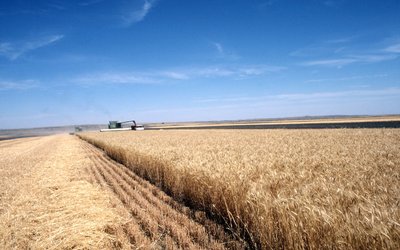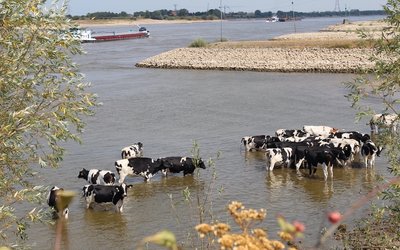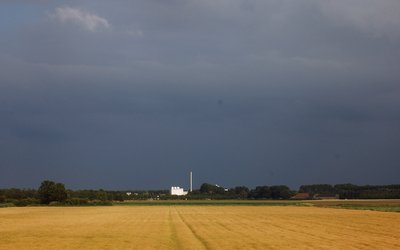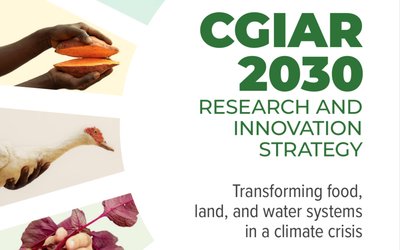Farmers in Eastern Europe will suffer more from climate change than their colleagues in the West
October 31, 2016

There is no such thing as a European response to climate change. Regions with the same increase in temperature and precipitation will have different impacts of climate change. This can be clearly illustrated for agriculture in Eastern and Western Europe.
Differences between Eastern and Western Europe
The same scenario of climate change will have different effects on agriculture in Eastern and Western Europe. These differences arise because today agriculture in Eastern Europe is not at the same high level as agriculture in Western Europe, and because the options to adapt to future climate change are not the same in these two regions.
The big difference of agriculture today between Eastern and Western Europe is illustrated by the difference in agricultural labour productivity: between 2011 and 2013 this productivity in Eastern Europe was only 19% of productivity in Western Europe. This is despite investment of approximately 20 billion euro of European Union (EU) and national funds to modernize Eastern European agriculture between 2000 and 2012. Apparently, transition of agriculture in Eastern Europe is a slow process.
Due to these big differences, Eastern and Western Europe do not have the same adaptive capacity or climate response, and thus face different climate change impacts. A farmer in Eastern Europe that is faced with a negative impact on a certain crop, for instance, has fewer options to adapt than a farmer in Western Europe facing the same impact for the same crop.
Adaptation gap Eastern Europe
Farmers will continue to adapt to changing circumstances to maximize their profit. This profit-maximization has different outcomes for Eastern and Western Europe. This hypothesis has been tested for changes in temperature and precipitation between now and 2071 - 2100 under scenarios of a moderate change in climate. For this test two assumptions have been assessed:
Adaptation in isolation
What if Eastern and Western European regions had to adapt in isolation? If agriculture in Eastern and Western Europe had to adapt in isolation, and thus farmers in Eastern and Western Europe could only benefit from adaptation options in their respective regions, this would negatively affect farmers in Eastern Europe. After all, the number of potential adaptation options is smaller in Eastern than in Western Europe: the variation in Eastern European farms is smaller, and agriculture is less developed, modernized, and capital-intensive than in Western Europe.
Same adaptive capacity for Eastern and Western Europe
What if farmers in both regions have the same options to adapt? The results show that if farmers in Eastern Europe have full and easy access to the adaptive capacity of Western Europe, Eastern Europe will respond more positively to changes in climate. Vice versa, having full access to the adaptive capacity of Eastern Europe does not increase the adaptive capacity of Western Europe.
Current situation
Both extremes are not realistic at this moment, however. Adaptation will not take place in isolation. There is an exchange of knowledge and expertise that strengthens adaptation capacity in Eastern Europe. Eastern European countries are continuing to re-adjust their institutions according to Western European templates, and Eastern European farmers have access to EU farm subsidies. The other end of the spectrum, where Eastern Europe gains access to the same level and quantity of adaptation options as Western Europe, is also unrealistic at this moment. Complex behavioural, technical, societal and institutional costs and adjustments at all levels of society are required to make this happen. Even though market principles are now predominant all over the European Union, and Eastern Europe has made a lot of progress to close the gaps, the countries in this region continue to face significant socio-economic setbacks that decrease the countries’ options to respond to the current and future climate.
Eastern European farmers suffer the most from climate change
Assessments of future impacts of climate change show that the region with the lowest adaptive capacity, Eastern Europe, suffers the most from climate change. This is because Eastern Europe cannot fully apply the same adaptation options as Western Europe. Autonomous adaptation will not bridge the existing adaptation gap. Planned adaptation in Eastern Europe is needed. The European Union, national governments, and regional policy must attempt to overcome the barriers to adaptation in Eastern Europe and increase Eastern European adaptive capacity by providing more information on adaptation opportunities and climate change, by enlarging the adaptation options and resource inventory and by creating a favourable implementation and management environment, by encouraging knowledge and skills transfer between all European farmers, and by guiding farmers in making efficient adaptation decisions.
Source: Vanschoenwinkel et al., 2016. Global Environmental Change 41: 74–87
Photo: Simon Ingram (www.flickr.com)








